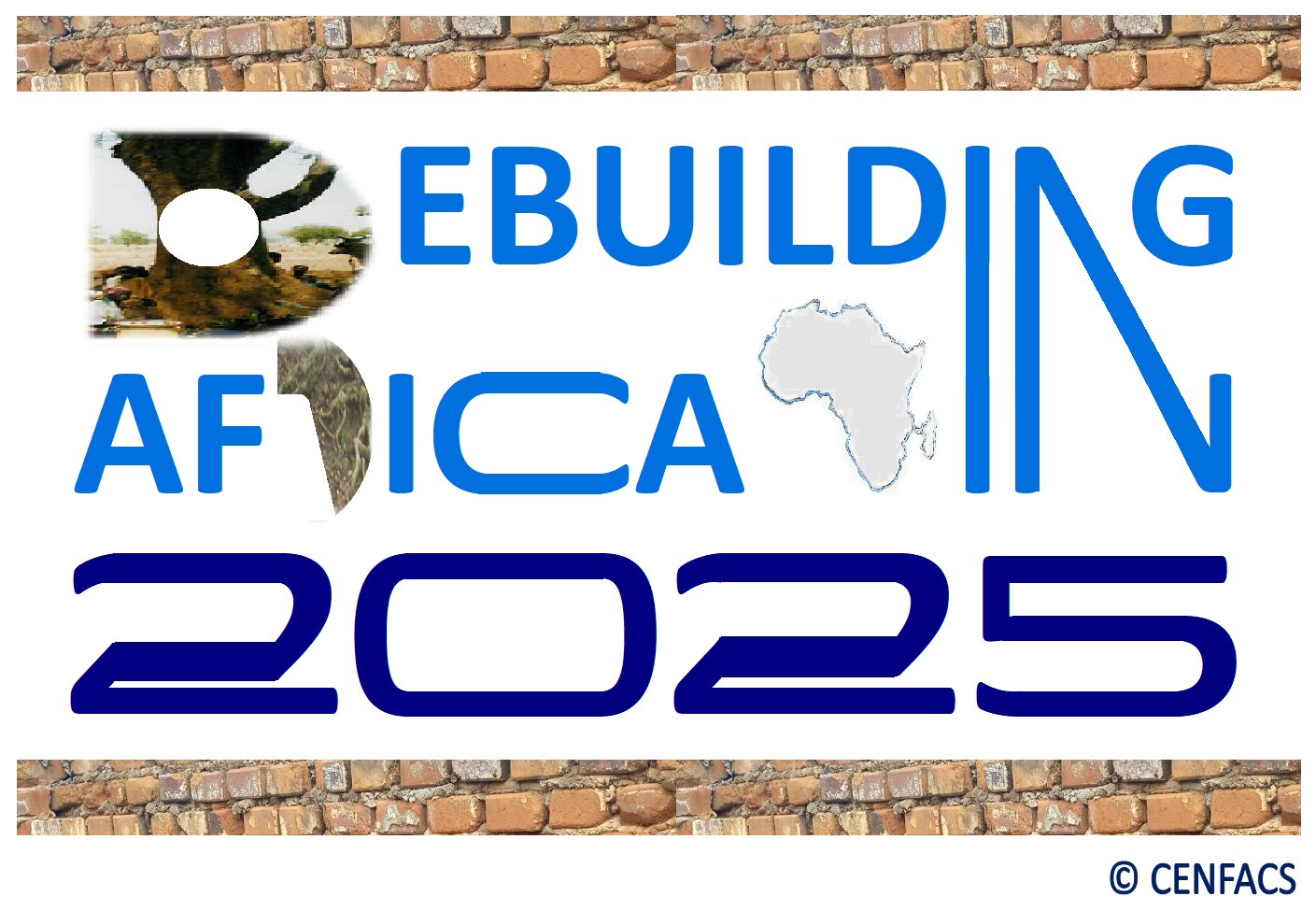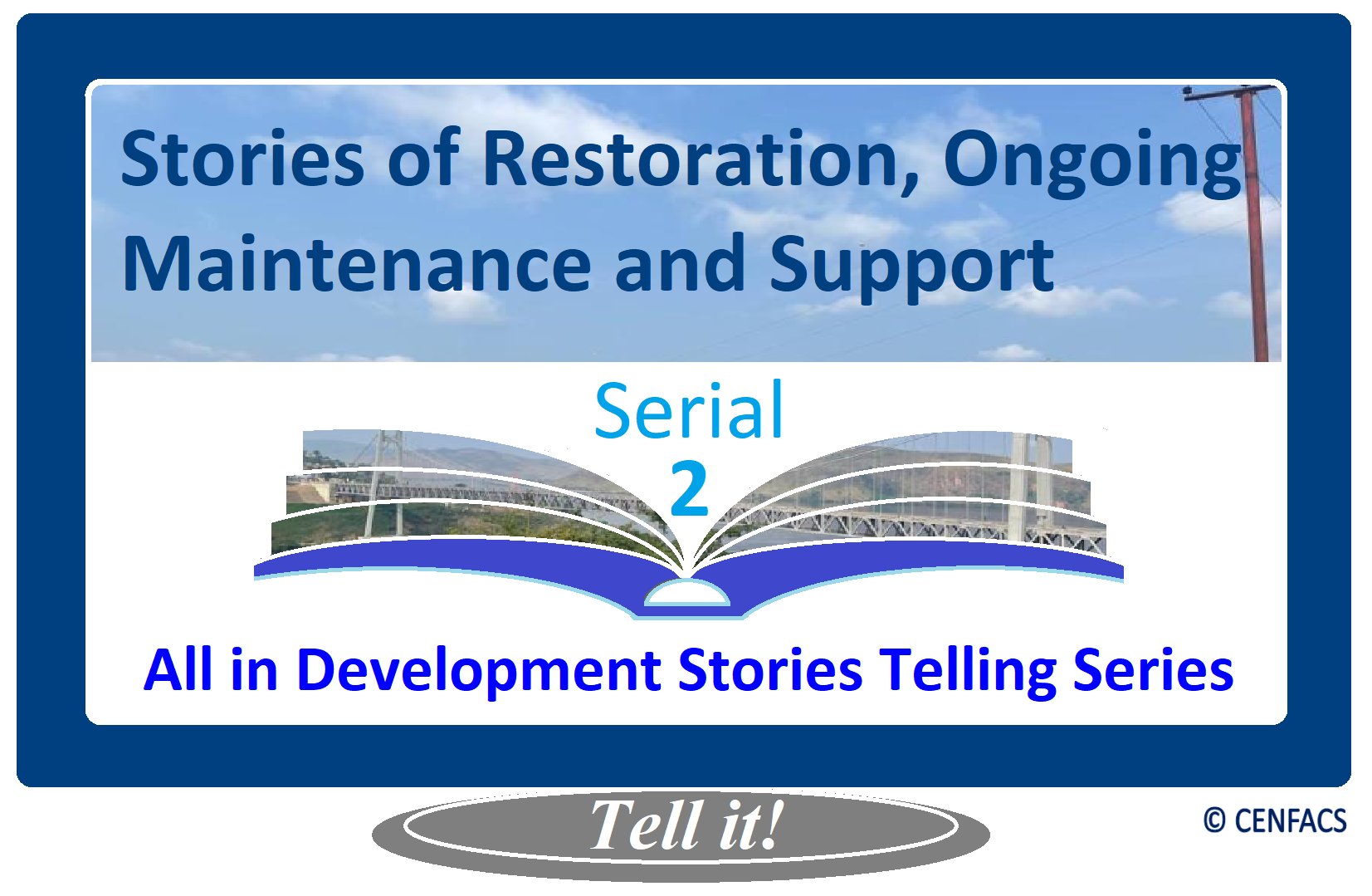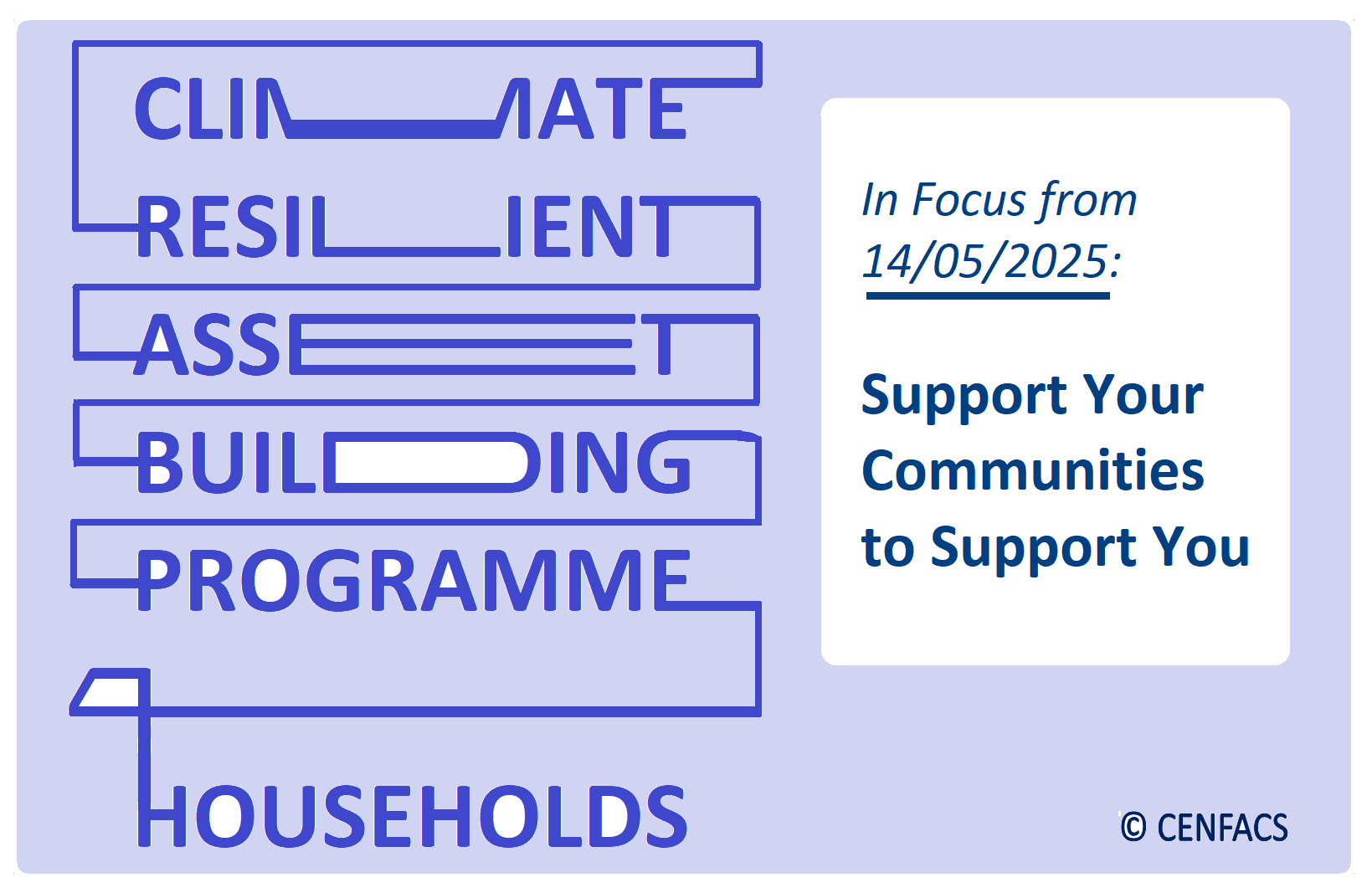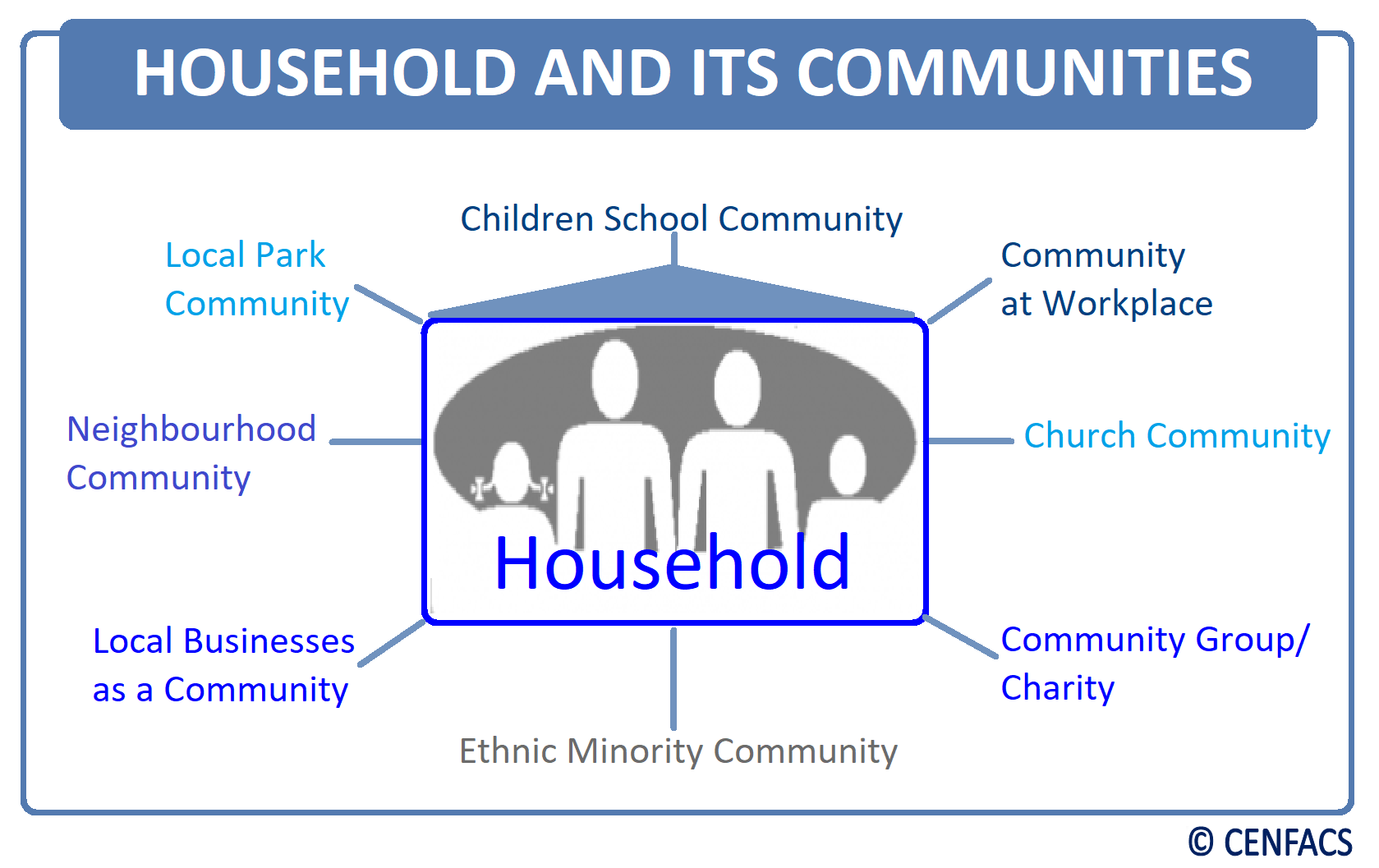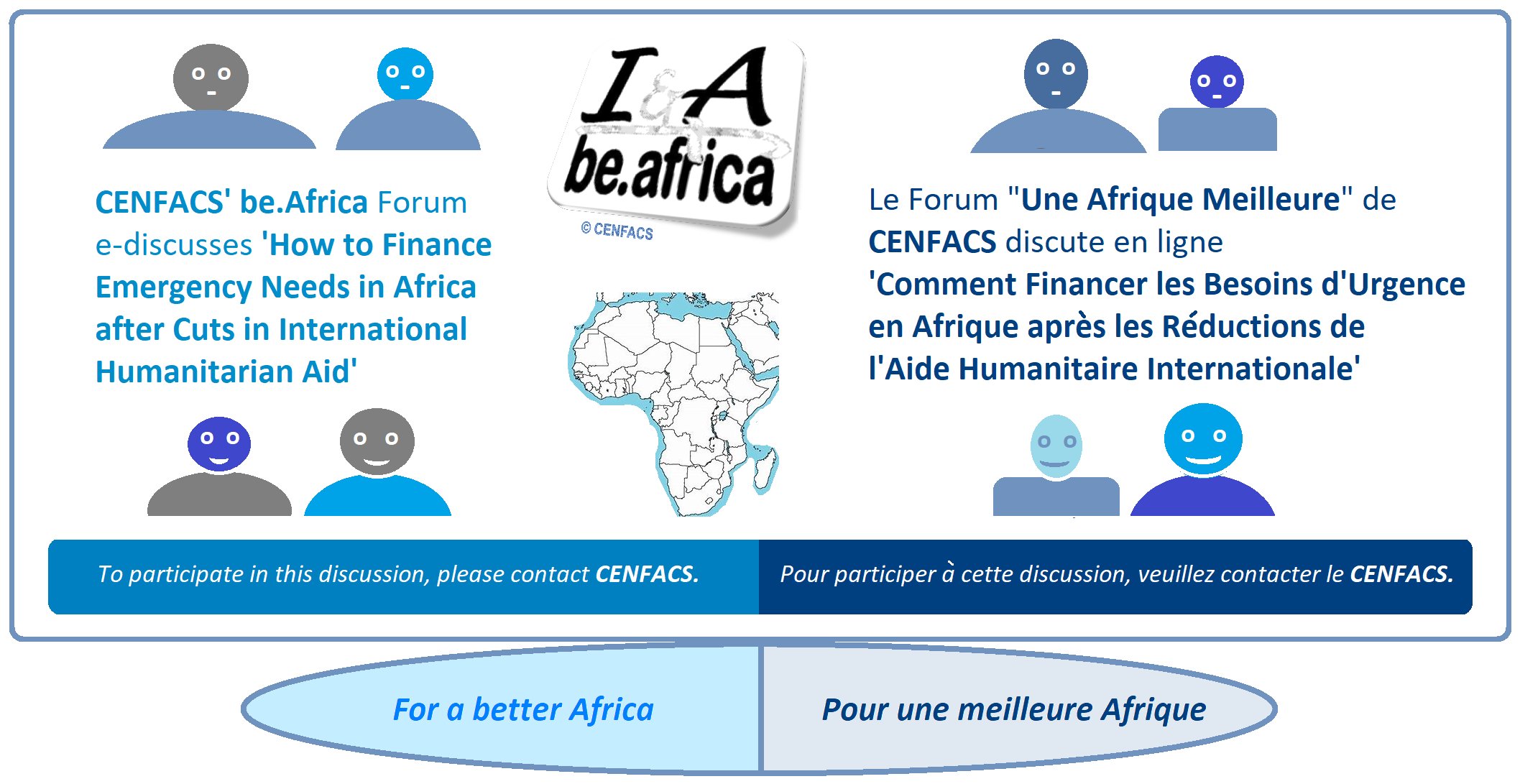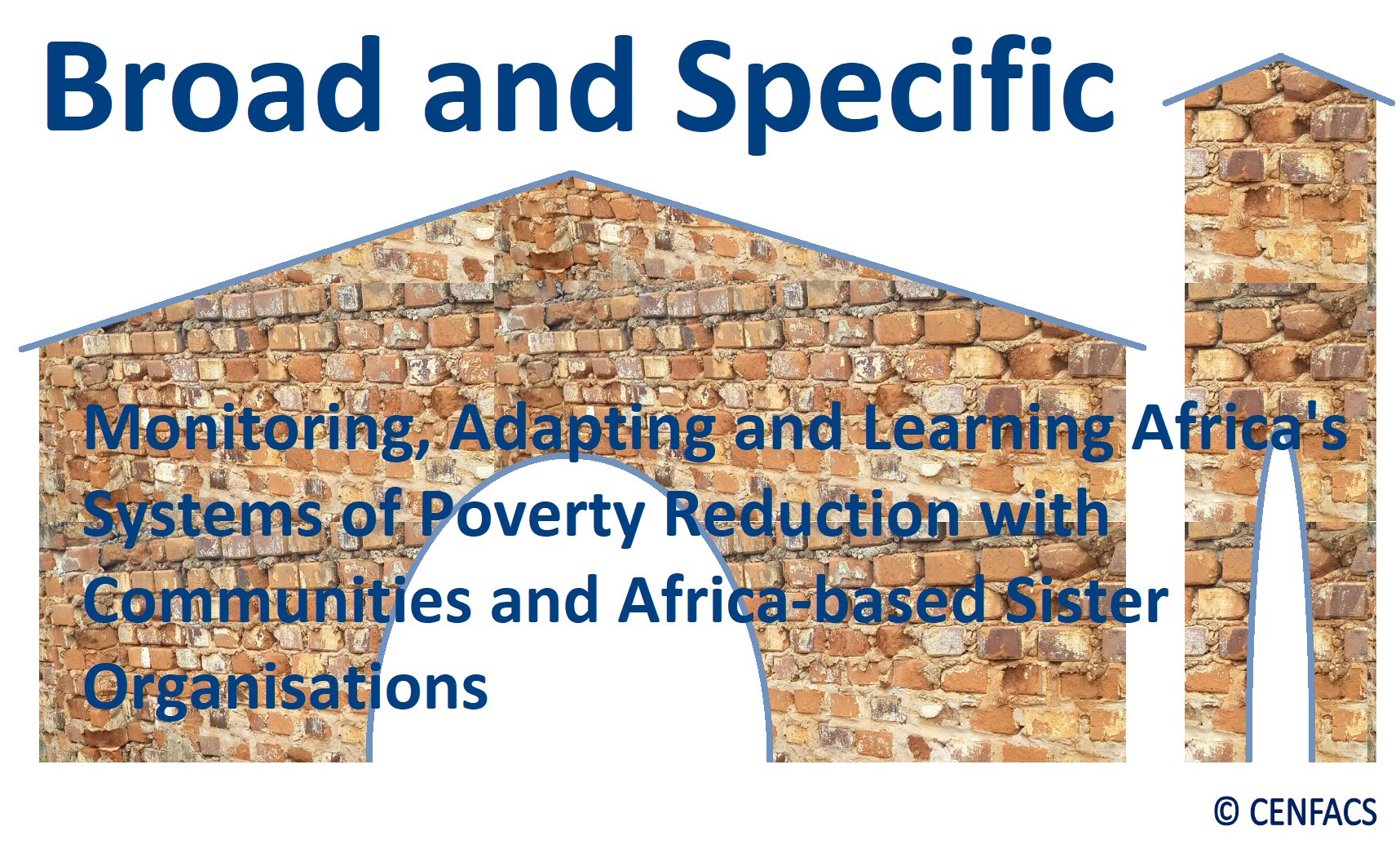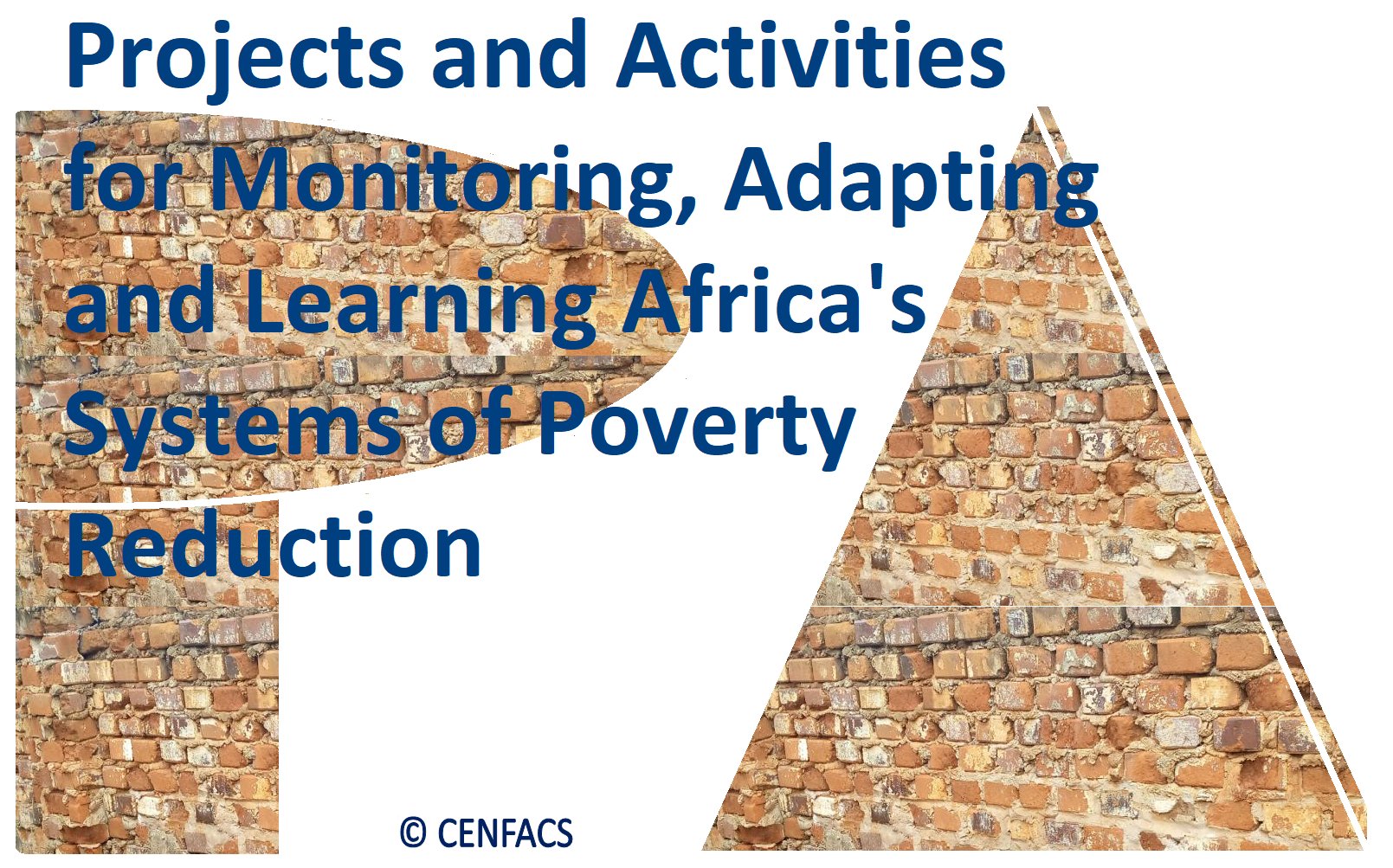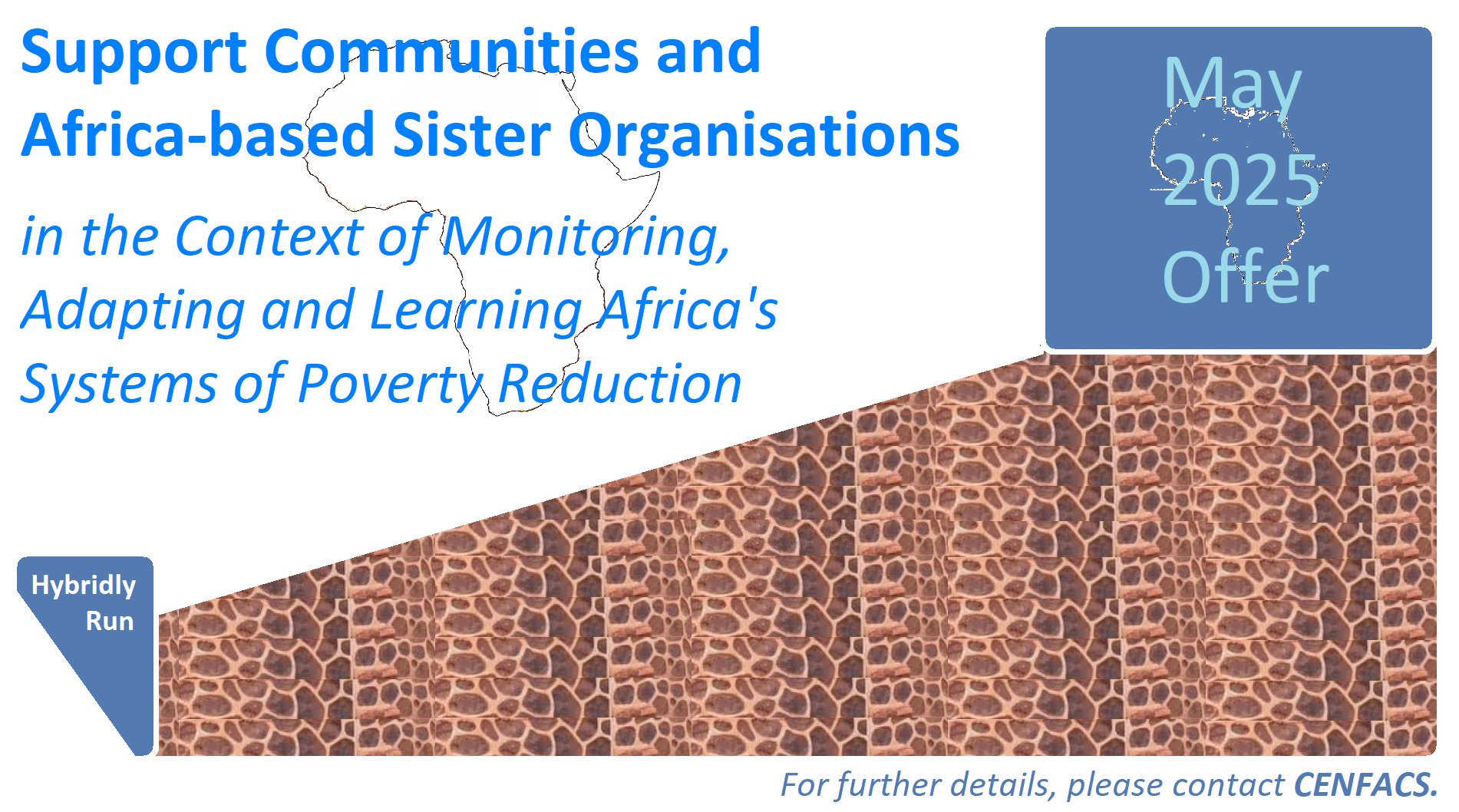Welcome to CENFACS’ Online Diary!
14 May 2025
Post No. 404
The Week’s Contents
• Rebuilding Africa in 2025 with a Focus on Monitoring, Adapting and Learning Africa’s Systems of Poverty Reduction
• All in Development Stories Telling Serial 2: Stories of Restoration; Stories of Ongoing Maintenance and Support (From Wednesday 14/05/2025)
• Climate-resilient Asset Building Programme for Households – In Consideration from 14/05/2025: Support Your Communities to Support You Build Climate-resilient Assets
… And much more!
Key Messages
• Rebuilding Africa in 2025 with a Focus on Monitoring, Adapting and Learning Africa’s Systems of Poverty Reduction
CENFACS does not only work in bringing and lighting a Blaze of Hope for the victims of destructive wars, natural disasters and other major crises (like the coronavirus shock or the cost-of-living crisis or aid emergency). CENFACS takes the process of working with these victims further in helping them to overcome underlying poverty and hardships induced by these events as well as supporting them to build their future.
CENFACS works with them and or their representative organisations to alleviate poverty and hardships as the lack of hopes and expectations. In the process of relieving poverty as the lack of hopes and expectations, the next step or phase of our advocacy is Rebuilding or Renewing Lives. We call it Rebuilding Africa. The latter depends on the events of the preceding and current years; events which determine the theme or focus of this rebuilding process.
• • The Focus for This Year’s Rebuilding Africa
This year, our Rebuilding Africa advocacy will focus on Monitoring, Adapting and Learning Africa’s Systems of Poverty Reduction.
Indeed, we shall work with communities in Africa and Africa-based Organisations to continuously monitor, adapt and learn from challenges, ensuring that Africa’s systems for poverty reduction remain robust and capable of thriving in the face of future uncertainties and threats.
This work will involve continuous monitoring, adaptability and flexibility, learning from experience, cultivation of adaptable leaders, thriving a cycle of resilience, anticipation, coping and adaptation, and resilience as a state of being.
Therefore, we shall have the following two types of rebuilding work:
a) Broad Monitoring, Adapting and Learning of Africa’s Systems of Poverty Reduction with Communities and Africa-based Organisations (ASOs) which will be based on the broad aspect of the rebuilding work;
b) Specific Monitoring, Adapting and Learning of Systems of Poverty Reduction with Communities and Africa-based Organisations where our ASOs operate will specifically deal with the particular aspects of the rebuilding work (like monitoring, adapting and learning of community members’ system of poverty reduction).
In both types (broad and specific) of rebuilding work, we shall look at monitoring, adaptiveness and learning of systems of poverty by using a multifaced approach, prioritising community-led solutions, focusing on sustainable development when working with communities. Similarly, we shall focus on building strong ties with ASOs and mutually beneficial partnerships, understanding local contexts, and focusing on sustainable solutions.
• • Where Rebuilding Africa Can Take Place
Rebuilding Africa can take place in any place in Africa that needs to be rebuilt or built forward. CENFACS‘ ASOs will be part of this rebuilding process.
There are ways in which ASOs can play their role in the rebuilding process where African countries need monitoring, adapting and learning about their systems of poverty reduction.
For instance, at this new era of international humanitarian aid cuts, many African countries will closely scrutinise the way they deal with their budgets (particularly aid budget), adapt to the new international development landscape and learn themselves from the way they approached foreign aid and direct investment in the past. This challenge in the international scene provides us food to monitor and learn Africa’s systems of poverty reduction as well as investigate where these systems need to adapt.
So, at this era of challenging and changing way of giving aid to Africa, there are many places where rebuilding work is needed in Africa and where our ASOs can be part of this rebuilding process and play their rebuilding role.
Further details about this advocacy work on Rebuilding Africa can be found under the Main Development section of this post.
• All in Development Stories Telling Serial 2: Stories of Restoration; Stories of Ongoing Maintenance and Support (From Wednesday 14/05/2025)
Our All in Development Story Telling Programme and Series continue with Serial 2, which is about Stories of Restoration after Resetting a System and Stories of Ongoing Maintenance and Support after Changing a System. Let us reveal the contents of this two-story series.
• • Stories of Restoration after Resetting a System
To provide these stories, let us refer to what ‘ask.com’ (1) argues about reset process and post-reset. The website ‘ask.com’ explains that when you reset your system, two things may happen: you can keep the contents (files) or remove everything. Keeping the files or contents will reinstall the operating system while retaining your personal contents or files. All applications will be removed. Removing everything will completely wipe your system of personal files and installed applications, returning it to its factory settings.
From this explanation of reset and post-reset processes, one can explain restoration.
• • • What is restoration?
Restoration can be approached in many ways. Referring to Oxford Dictionary of Environment and Conservation written by Chris Park (2), restoration is defined as
“The act of renovating or re-establishing something to close to its original condition, such as the structure and function of a damaged habitat or ecosystem” (p. 382)
Restoration can apply to a particular area of life. For instance, if one considers ecosystems, one can speak about ecosystem restoration. Ecosystem restoration means, according to ‘decadeonrestoration.org’ (3),
“Assisting in the recovery of ecosystems that have been degraded or destroyed, as well as conserving the ecosystems that are still intact”.
From the above-mentioned definitions, it is possible to identify stories of restoration after resetting a system.
• • • What are Stories of Restoration after resetting a system?
They are the narratives of any system post-reset action or process used to repair, re-establish, or renew tangible and intangible assets. To be more specific, they are those of
σ restoring data after reset and filling information in the storage space
σ reinstalling new contents or applications
σ troubleshooting issues relating to post-reset
σ rejuvenating the performance of your system
σ resolving post-reset problems
σ smooth transition into a new system
σ addressing common post-reset concerns
σ building post-reset confidence
etc.
If one considers ecological restoration, they could also be the tales of actively planting trees to help nature to recover on its own, and of removing greenhouse gases from the atmosphere.
If you are a member of our community and have this type of story, please do not hesitate to tell and share your story with CENFACS. If you are not our member, you can still submit your story.
To donate, tell and share your storying gift of Stories of Restoration after resetting a system, please contact CENFACS.
• • Stories of Ongoing Maintenance and Support after Changing a System
To understand these stories, it is better to explain Ongoing Maintenance and Support.
• • • What is Ongoing Maintenance? What is Ongoing Support?
Within the literature about system change, the two terms used are: system maintenance and post-implementation support.
A system maintenance is defined by ‘ecocomputernotes.com’ (4) as
“An ongoing activity, which covers a wide variety of activities, including removing programmes and design errors, updating documentation and test data and updating user support”.
System maintenance can be corrective, adaptive, preventive and perfective.
As to post-implementation support, the website ‘gomanagedit.com’ (5) explains that
“It refers to the range of activities and services provided after a new system, project or process has been implemented. The goal of this support is to ensure that the new implementation continues to function smoothly, address any issues that arises, and adapts to the evolving needs of the organisation”.
From these two definitions (of system maintenance and post-implementation support), it is possible to identify stories linked to them after changing a system.
• • • What are Stories of Ongoing Maintenance and Support after changing a system?
They are the plots relating to regular upkeep, and updates, and keeping system from falling. They are those of ensuring that your system or process stays maintained and supported.
To be precise, Stories of Ongoing Maintenance are those of
σ monitoring and evaluation
σ troubleshooting issues
σ training and support
σ system maintenance and updates
σ feedback collection
σ continuous improvement
etc.
As to Stories of Ongoing Support, they would be those of
σ ensuring system functionality
σ minimizing downtime
σ promptly addressing potential challenges
σ monitoring troubleshooting
σ ongoing training to better use the new system
σ post-implementation review
σ gathering lessons learned
σ feedback
σ system metrics
etc.
In short, Stories of Ongoing Maintenance and Support after changing a system are those of fixing errors, updating a system to accommodate changes in the poverty reduction environment or market, improving performance and ensuring that the changed system continues to meet people’s needs, especially the needs of the poor.
If you are a member of our community and have this type of story, please do not hesitate to tell and share your story with CENFACS. If you are not our member, you can still submit your story.
To donate, tell and share your storying gift of Stories of Ongoing Support after system change, please contact CENFACS.
• Climate-resilient Asset Building Programme for Households – In Consideration from 14/05/2025: Support Your Communities to Support You Build Climate-resilient Assets
A household can support its communities through various acts of service like volunteering, donating and neighbourhood activities. By supporting its communities, a household can find itself supported by its communities and build climate-resilient assets.
Perhaps, the best way of understanding how households supporting their communities can get support from the same communities, is to explain communities for households, provide the types of support that households can give to their communities and highlight how supporting communities can help households to build climate-resilient assets.
• • What Are Communities for Households?
It emerges from the literature on communities that communities for households can range from intentional cohousing communities to more traditional neighbourhoods with shared values and interests. They offer a sense of belonging, shared activities, and mutual support among residents, often fostering a stronger social fabric compared to isolated household living.
From the same literature, communities for households can be of different types like cohousing communities, neighbourhoods, communities of interest, etc. The key features among these communities for households are shared space and activities, mutual support, shared values and interests, active participation and the improvement of social fabric.
There are many ways that households can use to support the communities to which they are attached.
• • Ways of Supporting Communities by Households
There are many ways through which households can support their communities. They include the following:
~ Volunteering (spending their free time to community issues)
~ Doing the act of generosity by donating to communities’ good and deserving causes
~ Supporting local and community businesses by shopping locally
~ Attending community events
~ Taking environmental responsibility at community and local levels
~ Responding to communities’ communications (e.g., community survey)
etc.
Supporting in the above-mentioned ways can benefit both communities and households.
• • Support Your Communities to Support You Build Climate-resilient Assets
Supporting communities can help households build climate-resilient assets. This can happen by fostering collective action, sharing resources, and promoting sustainable practices that enhance resilience to climate change impacts. This can include strengthening community infrastructure, diversifying livelihoods, and empowering communities to manage risks and adapt to changing conditions.
There are many examples that can show that supporting communities can help households build climate-resilient assets. Among these examples are the following ones:
~ By working with their communities, households benefit from the pool of resources and share knowledge with other community members
~ Supporting community-based enterprises can help households diversify their income sources and reduce their over-reliance on climate-sensitive livelihoods
~ Community-led social protection programmes can provide financial assistance and support to households during climate-resilient shocks
~ Supporting community-led infrastructure projects can improve the overall resilience of the community to impacts; resilience which households could benefit
~ Helping community initiatives promoting energy efficiency and water conservation can help households build climate-resilient assets
~ Backing community-led education and awareness programmes can help households develop better coping strategies
~ Taking part in community climate planning and decision-making processes can help climate resilience measures to be aligned with households’ needs
etc.
These above-mentioned examples demonstrate that by supporting communities, households have a greater chance to build climate-resilient assets that can enhance their capacity to withstand and adapt to the adverse impacts of climate change.
For those households that would like to Build Climate-resilient Assets by Supporting Their Communities, they should not hesitate to contact CENFACS.
For any queries and/or enquiries about Support Your Communities in the context of Climate-resilient Asset Building Programme for Households (including how to access this programme), please do not hesitate to contact CENFACS.
• • Last Words about Climate-resilient Asset Building Programme for Households
Most households have assets and need to build or increase their value. There are many ways of building assets and increasing their value. One way of doing it is in a climate-resilient way. This is whether it is about building capacity or resilience into your home or incentivising finances or supporting communities. Climate-resilient asset building approach could be the best way of doing it. This is because Climate-resilient Asset Building Programme for Households focuses on ways of supporting households in building their overall resilience.
We would like to thank all those who have been with us throughout this programme and those who have been supportive towards it.
We would like as well to take this opportunity to announce that we shall soon run another programme to complement Climate-resilient Asset Building Programme for Households. This new programme for households will be called “Climate-conscious Investment Strategies for Households”. This is all part of our aim of continuously empowering households, particularly those making our community.

Extra Messages
• ReLive Issue No. 17, Spring 2025: The Returned Internally Displaced Persons in Africa Need Some Assistance to Rebuild and Renew Their Lives, Can You Help?
• Story Submission and Permission
• E-workshop for Gamers of CENFACS’ Poverty Reduction League: Create a Poverty Reduction League Table
• ReLive Issue No. 17, Spring 2025: The Returned Internally Displaced Persons in Africa Need Some Assistance to Rebuild and Renew Their Lives, Can You Help?
The Campaign will help
≈ give to the returnees a fresh start
≈ rebuild or repair infrastructures (like schools, water systems, roads and healthcare)
≈ them reintegrate and access rights
≈ them find housing and work
≈ them enrol children in schools
≈ them get cash assistance to cover initial basic needs such as personal hygiene items and rent, rehabilitate land
≈ in brief rebuild and renew lives in a gradual, safe and sustainable way.
The Campaign is done through Gifts of Renewing Lives or Life-renewing Projects (LRPs). We are running 14 Gifts in a world of 20 Reliefs or Helpful Differences. What does this mean?
It means donors or funders have 14 Gifts of Renewing Lives to choose from and 20 Reliefs to select from to make helpful differences to the returnees.
In total, our Spring Relief 2025 Campaign is providing to potential supporters 14 GIFTS of rebuilding returnees’ lives in Africa in 20 RELIEFS to make this happen.
For this renewal to happen, support is needed towards LRPs.
To support, go to http://cenfacs.org.uk/supporting-us/

• Story Submission and Permission
• • Story Submission
How to make your stories reach CENFACS and others in the community
Before submitting your story, it is better to check our Short Story Submission Rules.
• • • Short story submission rules
To submit your story, please align your story with our submission rules. Basically, these rules request any storyteller or giver to proceed with the following:
∝ Check CENFACS submission guidelines and deadlines
∝ Be mindful of CENFACS storytelling terms and conditions
∝ Follow entry instructions
∝ Include a short pitch of your story (approximately 32 words)
∝ Be concise and simple
∝ Submit early.

• • • Means or ways through which you can submit or donate your story
There are many means or ways through which you can submit or donate your story or impact story. You can only donate stories or impact stories since we do not buy or sell stories. We are not a literary agent or story publisher. Also, we do not accept AI-powered stories.
In the context of this Serial 2 of All in Development Story Telling Programme and Series, there are ways that one can use to do it, which include written text options, phone calls, audio storytelling and listening, short film experiences, and video options. Let us highlight each of these means.
• • • • Written text options
You can write your story in a textual format. You can use email, mobile phone, text messing system and CENFACS’ contact form; and send your story in the form of text. To do that, you need basic typing skills, not special skills. You can use the standard Manuscript Format (like a.docx or .doc file) with your last name and your story title.
• • • • Phone calls
You can call CENFACS and give your story via phone.
• • • • Audio storytelling and listening
You can use the capacity of audio to tell your volunteering story. Audio storytelling (with short digital narratives, podcasting, social media and online streaming) can help create and share the impact of the change you made or have made.
• • • • Short film experiences
You can make short films to support your storytelling experiences and create a social impact. You can make film on your smart phone with a video content. Shooting interviews with story participants can also help to create experiences that maximise social media and essential story contents.
• • • • Video options
You can use audio High Definition video calling (for example Skype video calls or Google Meet for video conferencing options) to tell and share you story with CENFACS and others.
If you are going to use video options, it is better to use a free option and non-profit programme, as they are accessible to everybody to join in with at home or wherever they are. By using this free option, you do not add any financial costs to anybody who wants to listen or follow your story.
Some of our users and members may not be able to afford to pay for some types of video options on the market. That is why it is better to use something which is accessible by the majority of people.
For the purpose of data protection, please use the security tips attached to your chosen option.
If you know you are going to tell your story via video calling or conferencing option or storytelling tools that are unfamiliar to the majority of people, and you want CENFACS to participate or join in, you need to let us know at least three days before your story calling or conferencing start so that we can plan ourselves.
You need as well to inform us about the date, time and possibly participants. You can email, phone, text or complete the contact form to let us know as we are busy like you.
If you have a story, you can tell and share with us and others via the above named means. And if you do not mind, we will circulate – with your permission – your stories within the CENFACS Community.
• • • Tracking your submissions
You can keep track of what you have submitted by contacting CENFACS.
• • Permission to Share a Story with CENFACS
Generally, when we ask people’s stories, we also seek permission to share their stories. This is because telling us your story does not necessarily mean that you have given us the permission to share it. Your permission could be verbal or written.
We review the conditions of permission in the light of the law. Our story telling and sharing policy includes as well images or any infographics making these stories or the use of AI-powered stories. Our story telling and sharing policy is available to story tellers on request.
To keep our Story Month within the spirit of this policy, we are dealing with copyright law, permissions and licensing in order to share your story contents. We are particularly working on copyright permissions that story donors need to give to us in order for us to share their stories.
Working on copyright permissions is about staying copyright compliant as far as permissions to share your story is concerned. In simple terms, it means we will ask you whether or not, you agree for us to share your story including imaging or infographic parts of your story.
We are as well responding to any questions linked to copyrights relating to sharing stories.
For those who may have any issues to raise with story telling and sharing in the context of CENFACS’ AiDS Telling and Sharing Programme and Series, they should not hesitate to contact CENFACS.

• E-workshop for Gamers of CENFACS’ Poverty Reduction League: Create a Poverty Reduction League Table
How to create your African Countries’ League Table when gaming for poverty reduction
As part of CENFACS’ All Year Round Play Project (that is, CENFACS Poverty Reduction League), we can work together to support you (as a gamer) create your league table as you play.
To create a Poverty Reduction Table for African countries, you can organise information about each country by focusing on poverty indicators, potential interventions and related challenges. There are steps or tasks to undertake.
• • Process and Procedure for Creating a League Table
You can start by listing African countries and then include columns for poverty reduction rates, factors contributing to poverty reduction (like good governance, education and less economic inequality).
You can create a poverty reduction table showing the following:
√ Your selected African team countries (by categorising them based on their levels of poverty reduction )
√ The number of criteria/indicators you can assess them against (like poverty rate, extreme poverty, poverty line, etc.)
√ The number of criteria/indicators any of them has passed
√ How many of them they average
√ How many of them they under-perform
√ How many of them they score against the opposition
√ How many of them they concede against the opposition
√ Points they earn or share for each game.
You can as well consider contributing factors to poverty reduction (like economic growth, good governance, education, less inequality, conflict resolution and political stability), potential poverty relief interventions, and other elements.
By systematically and continuously recorded the results, scores and actions of your game fixtures via this table, you will in the end know which African country that would best reduce poverty by the end of 2025.
To process and proceed with a league table, one needs to have some economic indicators as criteria for measuring the performance of each country making CENFACS’ League of Poverty Reduction.
• • Example of Poverty Reduction Indicators to Create a League Table
For example, those who would like to go extra miles in the workshop, they can work with us using classes of indicators (that is, input, process and impact) for monitoring and tracking the poverty reduction performance as provided by the World Bank (6). Poverty indices like headcount index, poverty gap index and squared poverty index can be utilised when dealing with your league table. They can also include rural terms of trade and unskilled wage index in their table.
To access this e-workshop and get the grips with skills and techniques to create your poverty reduction league table, just contact CENFACS.
Message in English-French (Message en Anglais-Français)
• CENFACS’ be.Africa Forum E-discusses ‘How to Finance Emergency Needs in Africa after Cuts in International Humanitarian Aid’
International humanitarian aid to Africa has been cut amid emergency needs in some places in Africa have not been delivered. Many humanitarian agencies and the beneficiaries of these needs are wondering where financial resources will come to fill the gaps left.
As part of CENFACS’ be.Africa Forum’s discussions, we are debating this:
How to Finance Emergency Needs in Africa after Recent Cuts in International Humanitarian Aid.
Perhaps the starting point of this debate is to explain emergency needs. The website ‘lawinsider.com’ (7) argues that
“Emergency need means a situation that requires an immediate change in services, in service providers, or in both services and service providers, and is necessary for the health or safety of the consumer”.
The website ‘ifrc.org’ (8) speaks about the assessment of these needs which include food, safe drinking water, shelter, essential items (such as blankets, heaters and water containers), medical care, sanitation and waste disposal, psychological support and protection. Their assessment could be initial, rapid and in-depth.
As one can notice, these needs are required to be funded to maintain life of those who need them. However, how to fund them and where the funding is going to come under the constraint of international humanitarian aid. This is our e-discussion.
Those who may be interested in this discussion can join our poverty reduction pundits and/or contribute by contacting CENFACS be.Africa Forum, which is a forum for discussion on poverty reduction and sustainable development issues in Africa and which acts on behalf of its members by making proposals or ideas for actions for a better Africa.
To contact CENFACS about this discussion, please use our usual contact address on this website.
• Le Forum ‘Une Afrique Meilleure’ de CENFACS discute en ligne ‘Comment peut-on financer les besoins d’urgence en Afrique après les réductions de l’aide humanitaire internationale?’
L’aide humanitaire internationale à l’Afrique a été réduite alors que les besoins d’urgence dans certaines régions d’Afrique n’ont pas été satisfaits. De nombreuses agences humanitaires et les bénéficiaires de ces besoins se demandent d’où viendront les ressources financières pour combler les lacunes laissées. Dans le cadre des discussions du Forum ‘Une Afrique Meilleure’ de CENFACS, nous débattons de la question suivante :
Comment peut-on financer les besoins d’urgence en Afrique après les récentes réductions de l’aide humanitaire internationale?
Peut-être que le point de départ de ce débat est d’expliquer les besoins d’urgence.
Le site Web ‘lawinsider.com’ (7) soutient que “Le besoin d’urgence signifie une situation qui nécessite un changement immédiat dans les services, dans les prestataires de services, ou dans les deux, et qui est nécessaire pour la santé ou la sécurité du consommateur”.
Le site Web ‘ifrc.org’ (8) parle de l’évaluation de ces besoins qui incluent la nourriture, l’eau potable, l’abri, les articles essentiels (comme des couvertures, des chauffages et des contenants d’eau), les soins médicaux, l’assainissement et l’élimination des déchets, le soutien psychologique et la protection. Leur évaluation pourrait être préliminaire, rapide et approfondie.
Comme on peut le constater, ces besoins doivent être financés pour maintenir la vie de ceux ou celles qui en ont besoin. Cependant, comment peut-on les financer et d’où viendra le financement sous la contrainte de l’aide humanitaire internationale coupée ? C’est notre discussion en ligne.
Ceux ou celles qui pourraient être intéressé(e)s par cette discussion peuvent se joindre à nos experts en réduction de la pauvreté et/ou contribuer en contactant le ‘me.Afrique’ du CENFACS (ou le Forum ‘Une Afrique Meilleure’ de CENFACS), qui est un forum de discussion sur les questions de réduction de la pauvreté et de développement durable en Afrique et qui agit au nom de ses membres en faisant des propositions ou des idées d’actions pour une Afrique meilleure.
Pour contacter le CENFACS au sujet de cette discussion, veuillez utiliser nos coordonnées habituelles sur ce site Web.

Main Development
• Rebuilding Africa in 2025 with a Focus on Monitoring, Adapting and Learning Africa’s Systems of Poverty Reduction
The following sub-headings explain our advocacy about Rebuilding Africa in 2025:
a) Rebuilding as a Next Step after Bringing and Lighting a Blaze of Hope
b) The Concepts of Poverty Reduction System and Project Planning
c) Broad and Specific Monitoring, Adapting and Learning of Africa’s Systems of Poverty Reduction with Communities and Africa-based Organisations (ASOs)
d) Projects and Activities of Learning, Monitoring and Adapting Systems of Poverty Reduction in Africa
e) Working with Communities and Africa-based Organisations on Africa’s Poverty Reduction Systems.
Let us briefly explain the contents of these sub-headings.
• • Rebuilding as a Next Step after Bringing and Lighting a Blaze of Hope
As argued in the Key Messages, Rebuilding is the next step in our process of helping in reducing the impacts and effects of war and natural disaster events or any other major crises or shocks. Saying that we are going to rebuild Africa, it does not mean that we are going to remake all the sectors of Africa from scratch.
Rebuilding in the context of our poverty relief work has to be placed in the perspective of working with and helping poor people and their organisations to overcome the ill effects of wars and natural disasters or any other major crises (like misinformation, disinformation, extreme weather events, and social polarization). It is down to Africans to rebuild Africa, not CENFACS. CENFACS as a charity just gives a helpful hand to them to reduce or better end poverty.
• • • What Rebuilding Africa is about
Rebuilding Africa addresses the legacies left by destructive war and natural disaster events or any other major crises or shocks like the coronavirus, the cost-of-living crisis and international aid cuts. Every year, many human and wild lives as well as other ways of life have been destroyed as a result of wars, armed conflicts, economic shocks and environmental disasters. These events often lead to humanitarian catastrophes, emergencies, contingencies, crises and responses.
What’s more, where there is destructive war, there is always a destruction of the environmental life. Examples of these destroyed lives are what happened in the Democratic Republic of Congo, in Chad, in the Central African Republic, Burkina Faso, Mali, etc.
Rebuilding Africa initiative is a response to these events by undertaking projects planning and development activity within CENFACS, with communities and in association with our Africa-based sister organisations.
What will Rebuilding Africa initiative will about for this year?
• • • Rebuilding Africa in 2025
Rebuilding Africa in 2025 will be about Monitoring, Adapting and Learning Africa’s Systems of Poverty Reduction. At this new era of international humanitarian aid cuts to Africa, there is a great need to (re)learn, monitor and adapt Africa’s Systems of Poverty Reduction. To respond to this need or challenge, we shall have the following two types of rebuilding work:
a) Broad Monitoring, Adapting and Learning of Africa’s Systems for Poverty Reduction with Communities and Africa-based Organisations (ASOs) which will be based on the broad aspect of the rebuilding work;
b) Specific Monitoring, Adapting and Learning of Systems for Poverty Reduction with Communities and Africa-based Organisations where our ASOs operate will specifically deal with the particular aspects of the rebuilding work (like monitoring, adapting and learning of community members’ system of poverty reduction).
However, before going any further let us clarify the concepts of poverty reduction system and project planning.
• • The Concepts of Poverty Reduction System and Project Planning
These concepts are central in the process of rebuilding and they need explanation. Let us explain them.
• • • Understanding Poverty Reduction System
Poverty reduction system can be approached in many ways. In the context of Rebuilding Africa in 2025, a poverty reduction system refers to a set of interconnected or interrelated parts forming a complex whole of measures both economic and humanitarian designed to lift people out of poverty and improve the quality of life. The system involves a combination of policies and programmes aimed at increasing income, providing essential services, and creating opportunities for the poor.
The poverty reduction system we are dealing with is the Africa one. The literature about Africa’s poverty reduction system indicates that Africa’s poverty system encompasses a variety of approaches, including structural reforms, investment in social sectors, and addressing global challenges like commodity price fluctuations and agricultural subsidies. It also involves empowering individuals and communities through education, healthcare, and access to resources, as well as promoting economic diversification and job creation.
However, Africa is a continent. There could many systems of poverty reduction depending on countries and areas of focus. Most of these systems would have something in common which is lifting people out of poverty and improving the quality of their life. These systems can be learned, monitored and adapted in line with the changing development landscape like the current environment of international humanitarian aid cuts and crises. One way to adapt these systems is to plan and develop a number of projects that will make up the new system.
• • • Projects Planning and Development
Project planning can be approached in many ways. According to ‘coursera.com’ (9),
“Project planning is the second stage of the project management lifecycle. The full cycle includes initiation, planning, execution, monitoring, controlling, and closing. Project planning refers to the phase in project management in which you determine the actual steps to complete a project. This includes laying out timelines, establishing the budget, setting milestones, assessing risks, and solidifying tasks and assigning them to team members”.
In terms of Projects Planning and Development process within CENFACS, this process enables us to know the needs on the grounds and reach out to those in most need in Africa. It also assists to improve our way of doing development work, to rethink and exchange new ideas, avenues, approaches, theories, frameworks of analysis and projects to systematically respond to the way in which we are going to proceed with our rebuilding work. In the context of Rebuilding Africa in 2025, the plan will be to Broadly and Specifically Monitor, Adapt and Learn Africa’s Systems for Poverty Reduction with Communities and Africa-based Organisations.
• • Broad and Specific Monitoring, Adapting and Learning of Africa’s Systems of Poverty Reduction with Communities and Africa-based Organisations
These two aspects (that is, broad and specific ones) can be highlighted as follows.
• • • Broad Monitoring, Adapting and Learning of Africa’s Systems of Poverty Reduction with Communities and Africa-based Organisations
This broad aspect can be explained in the terms highlighted below.
~ Broad monitoring of Africa’s poverty reduction systems can be done by using a combination of data collection analysis, and evaluation methods. This includes monitoring poverty rates, analysing the effectiveness of specific interventions (like the ones provided by ASOs), and assessing the impact of broader sustainable development policies on poverty reduction in Africa.
~ Regarding the adaptation of Africa’s poverty reduction systems, this can be undertaken by focusing on sustainable agriculture, continuing to invest in education and healthcare, empowering women, promoting inclusive economic growth, and unlocking the creative economy (that is, music, film and digital industries). This includes having self-reliant poverty reduction strategies, levying green taxation, improving rural infrastructure, enhancing financial inclusion and diversifying economies.
~ Concerning learning of Africa’s Poverty Reduction Systems, Africa’s poverty reduction efforts offer valuable lessons, emphasising the importance of sustainable economic growth, addressing inequalities, investing in human capital, focussing on specific sectors like agriculture and health.
These three elements (that is, monitoring, adaptation and learning) of dealing with Africa’s poverty reduction systems can be undertaken by working with communities and ASOs. Communities in Africa and ASOs can shape the way in which one approaches monitoring, adaptation and learning in this matter by providing specific and practical way of doing it.
• • • Specific Monitoring, Adapting and Learning of Africa’s Systems of Poverty Reduction with Communities and Africa-based Organisations
~ Specific monitoring of Africa’s Poverty Reduction Systems could be applied to
≈ data collection, in particular by considering household surveys, social surveys, data from development agencies (like non-governmental organisations and ASOs), big data and machine learning, climate data, etc.
≈ analysis and evaluation by using poverty measures (like poverty headcount ratio, poverty gap, and poverty severity), impact evaluation, cost-effectiveness analysis, social impact assessment, political economy analysis, etc.
~ Specific adaptation of Africa’s Poverty Reduction Systems will try to look at specific actions in terms of
≈ supporting sustainable agriculture and food security (like boosting productivity)
≈ education and skills (for instance, the development of relevant skills to deal with new ways of funding development)
≈ healthcare and social protection (e.g., ways of improving healthcare access)
≈ economic growth and diversification (like the promotion of trade within African Intracontinental Free Trade Area)
≈ good governance (e.g., transparency and accountability for aid budget and effectiveness)
≈ addressing inequalities and vulnerabilities (for instance, measures to protect vulnerable sections of populations)
≈ external support (such as philanthropic investments)
etc.
~ Specific adaptation of Africa’s Poverty Reduction Systems will be about
how Africa’s ecosystem of poverty reduction is strategically adapting to cope with competition and change in the global environment (for instance, how Africa is dealing with tariff war and de-globalisation threat). It means looking at Africa’s adaptive capacity, that is a measure of the extent to which Africa’s ecosystem is able to adjust to environmental change or the new global development landscape. This can also involve Africa’s policies and actions to prevent or reduce the adverse impacts of climate change.
To monitor Africa’s Poverty Reduction Systems, deal with with their adaptation as well as learn from these systems, it may require to plan and develop some projects as well as the undertaking of certain activities.
• • Projects and Activities of Learning, Monitoring and Adapting Systems of Poverty Reduction in Africa
• • • Projects of Learning, Monitoring and Adapting Systems of Poverty Reduction in Africa
They are a series of interrelated tasks and activities planned and to be executed to achieve the objectives of learning, monitoring, and adapting systems of poverty reduction within specific constraints of time, costs and resources. They are planned pieces of work that aim to monitor, learn and find out adaptive capacity of Africa’s poverty reduction systems.
These projects could be or include the following:
~ Impact evaluation projects to assess the effectiveness and lessons learned from poverty reduction programmes
~ Social impact assessment of funded projects to check if the best value is obtained from investment made
~ Projects of tracking progress in poverty reduction for work carried out by ASOs
~ Projects integrating climate and poverty
~ Projects to find the effects of programmes run by ASOs on gender equality, social inclusion and empowerment
etc.
• • • Activities of Learning, Monitoring and Adapting Systems of Poverty Reduction in Africa
They are specific actions or doing something to learn, monitor and find out about adaptation of Africa’s systems of poverty reduction.
These activities could include:
~ Conducting surveys with ASOs to gather their perceptions about new ways of funding their work
~ Advocacy/appeals to philanthropic global organisations and major donors to support ASOs in the era of international aid cuts
~ Advising ASOs to explore social enterprise models (that is, income-generating initiatives)
~ Running workshops on financial self-reliance and self-sufficiency policies to reduce ASOs reliance on international foreign aid
~ Providing guidance and information on private-charity partnerships for poverty reduction and sustainable development in Africa
~ Campaigning with ASOs to raise private donations locally
~ Organising focus groups on alternative funding mechanisms
etc.
The above-mentioned projects and activities will be conducted to help communities and ASOs to meet their goals of
“moving forward to protect the gains or legacies of our building-forward-better-together work while building upon progress to achieve a more equitable and inclusive society”.
However, to realise these projects and activities, it is better to work with communities and ASOs in Africa.
• • Working with Communities and Africa-based Organisations on Africa’s Poverty Reduction Systems
• • • Working with Communities on Africa’s Poverty Reduction Systems
Working with Communities on Africa’s Poverty Reduction Systems to reduce poverty will involve the following:
~ Supporting community-led initiatives
~ Economically empowering those in need
~ Developing human capital
~ Enhancing socio-economic inclusion and addressing gender inequalities
~ Developing poor people’s infrastructure and promoting access to basic services
~ Sustaining development
~ Building partnerships and collaborate with these communities
etc.
• • • Working with Africa-based Organisations on Africa’s Poverty Reduction Systems
Working with ASOs on Africa’s Poverty Reduction Systems will be about the following:
~ Selecting organisations to partner with and building better relationships with them
~ Understanding the local context
~ Focussing on sustainable solutions
~ Effectively collaborating
etc.
This will involve identifying organisations with proven track records, aligning our goals with theirs, and ensuring that our efforts contribute to local development rather than simply providing aid.
The above-mentioned areas of work with communities and ASOs will be undertaken through our capacity building, advocacy, advice, networking, and signposting services.
For those Communities and Africa-based Sister Organisations that are looking to working with us, CENFACS is prepared to work with them on Rebuilding Africa.
CENFACS can work with them to ensure that Africa’s Poverty Reduction Systems deliver their goals.
We can work with them under our International Advice-, Guidance- and Information-giving Service.
For further details about Rebuilding Africa in 2025, please also contact CENFACS.
_________
• References
(1) https://www.ask.com/news/expect-windows-reset-recovery-reinstallation-tips (accessed in May 2025)
(2) Park, C. (2011), Oxford Dictionary of Environment and Conservation, Oxford University Press, Oxford & New York
(3) https://www.decadeonrestoration.org/what-ecosystem-restoration (accessed in May 2025)
(4) https://ecocomputernotes.com/mis/implementation-and-evaluation/what-is-system-maintenance-what-are-its-different-types (accessed in May 2025)
(5) https://gomanagedit.com/what-is-post-implementation-support/ (accessed in May 2025)
(6) https://documents.worldbank.org/en/publication/documents-reports/documentationdetail/27201468765605934/indicators-for-monitoring-poverty-reduction (accessed in May 2023)
(7) https://www.lawinsider.com/dictionary/emergency-need#:~text= (accessed in May 2025)
(8) https://www.ifrc.org/our-work/disasters-climate-and-crises/supporting-local-humanitarian-action/emergency-needs (accessed in May 2025)
(9) https://www.coursera.org/articles/project-planning (accessed in May 2023)
_________
• Help CENFACS Keep the Poverty Relief Work Going This Year
We do our work on a very small budget and on a voluntary basis. Making a donation will show us you value our work and support CENFACS’ work, which is currently offered as a free service.
One could also consider a recurring donation to CENFACS in the future.
Additionally, we would like to inform you that planned gifting is always an option for giving at CENFACS. Likewise, CENFACS accepts matching gifts from companies running a gift-matching programme.
Donate to support CENFACS!
FOR ONLY £1, YOU CAN SUPPORT CENFACS AND CENFACS’ NOBLE AND BEAUTIFUL CAUSES OF POVERTY REDUCTION.
JUST GO TO: Support Causes – (cenfacs.org.uk)
Thank you for visiting CENFACS website and reading this post.
Thank you as well to those who made or make comments about our weekly posts.
We look forward to receiving your regular visits and continuing support until the end of 2025 and beyond.
With many thanks.
